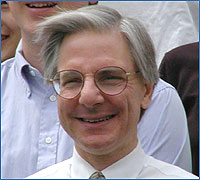
David Eric Golan, Ph.D., M.D.
Our goals are to understand the molecular interactions controlling protein and lipid mobility and distribution in cell membranes, the roles these mechanisms play in interactions between cells, and the relationships between derangements in these mechanisms and the pathophysiology of disease. We have designed and constructed several time-resolved scanning laser microscopes for interactive monitoring, tracking, and manipulating of biological samples at the single-cell and single-molecule levels on the µs-ms time scale and nm distance scale. Using these instruments, we are investigating: 1) Molecular interactions in erythroid cell membranes. We aim to define the modes of motion and strengths of interactions involving individual molecules in the mature red cell membrane, and to investigate the development of a functional membrane skeleton during erythroid cell differentiation. 2) Single molecule analysis of sickle erythrocyte adhesion. We aim to define the molecular mechanisms mediating adhesion of sickle red cells to activated T lymphocytes, monocytes, neutrophils and endothelial cells, and to investigate correlations between the level of adhesion and the pathophysiology of painful crisis episodes in patients with sickle cell disease. 3) Molecular interactions in immune synapse formation. We aim to define the modes of motion, cell surface distribution, and two-dimensional binding interactions of T-cell adhesion molecules in natural and artificial membrane systems. 4) Quantitative analysis of the interaction between lipopolysaccharide (LPS) from Pseudomonas aeruginosa and the cystic fibrosis transmembrane conductance regulator (CFTR) protein. We aim to quantify the physical properties of LPS and CFTR at sites of contact between P. aeruginosa and pulmonary epithelial cells, and to characterize the molecular mechanisms mediating uptake of LPS by such cells. 5) Cellular imaging of protein-protein interactions: visualizing the dynamic regulation of eNOS and caveolin in calcium-dependent signal transduction. We aim to visualize the dynamic regulation of endothelial nitric oxide synthase, caveolin, and related signaling molecules in vascular cells in culture and in the intact vasculature. Graduate student rotation projects are available in each of these areas.
Our goals are to understand the molecular interactions controlling protein and lipid mobility and distribution in cell membranes, the roles these mechanisms play in interactions between cells, and the relationships between derangements in these mechanisms and the pathophysiology of disease.
Address:
Room SGM - 304C
240 Longwood Avenue
Boston, MA 02115